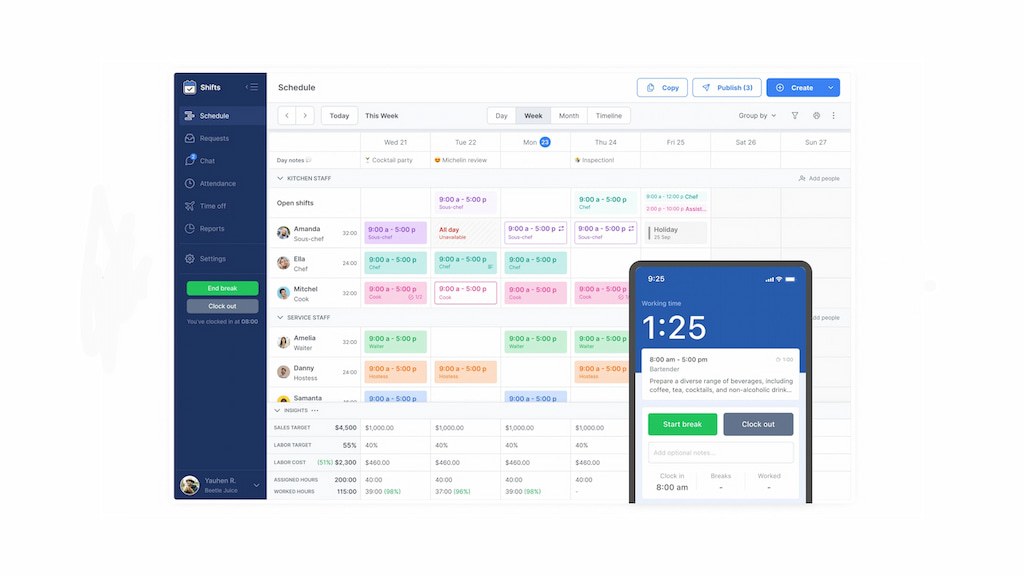Group chats and spreadsheets can’t keep up with real-world chaos. You need employee rostering software that builds fast, prevents mistakes, and adapts in minutes—not hours. In this guide, you’ll learn exactly how to evaluate the best employee rostering software in 2025, including Shifts by Everhour, what to prioritize for your team size and constraints, and how to roll out a workflow that cuts overtime, protects compliance, and keeps staff happy.
What Is Employee Rostering Software?
Employee rostering software—also called employee scheduling or shift planning—answers three key questions every day: who works, where, and when.
Modern platforms go further, helping you manage:
- 📅 Availability & time off: Track when staff can or cannot work.
- 🔄 Open shifts & swaps: Let employees claim or trade shifts easily.
- ⚠️ Conflict alerts: Prevent double-booking, overtime, or rest rule violations.
- ⏱️ Attendance integration: Compare scheduled vs. actual hours for accurate payroll and labor cost control.
Top tools in the market include Shifts by Everhour, Connecteam, Deputy, Homebase, 7shifts, Sling, Shiftboard, QuickBooks Time, and more—offering flexible solutions for teams of all sizes.

Why It Matters in 2025
Labor volatility, compliance pressure, and distributed teams have turned scheduling from a “nice-to-have” into a core operations system. Modern rostering impacts three key areas:
- 💰 Financial accuracy: Scheduled vs. actual reporting helps spot overtime or duplicate coverage before it hits payroll.
- ⚖️ Compliance and risk: Built-in rules prevent rest or hour violations at creation, not after an audit.
- 🙌 Employee experience: Fair, predictable rosters with mobile self-service (confirmations, swaps, open shifts) boost morale and reduce turnover.
Key Features, Trade-Offs, and Real-World Use Cases
⏱ Scheduling speed and clarity
If managers can’t build next week’s roster in under an hour, it impacts operations everywhere. Look for:
- Drag-and-drop shifts
- Recurring templates and copy-week tools
- Clear role/location views
- Conflict warnings (double-booking, overtime, rest windows)
Use case: A three-site café clones a “base week,” tweaks coverage for a sports event and delivery peaks, cutting build time from half a day to under an hour.
🧩 Staff self-service and fewer bottlenecks
Empower staff with:
- Availability inputs
- Time-off requests
- Swap/drop workflows
- Open shifts staff can claim
Push notifications inform without spamming, and approvals remain auditable.
Use case: A clinic posts two unfilled Saturday shifts; qualified staff claim them within hours—no back-channel scramble.
📊 Attendance and the reality layer
Track actual hours to avoid guessing. Integrations or built-in time tracking help:
- Reconcile scheduled vs. actual hours
- Improve payroll accuracy
- Control overtime
- Maintain compliance audit trails
Use case: A warehouse identifies recurring 30-minute overruns on night shifts; adding a handover buffer eliminates chronic overtime.
⚖️ Compliance and rule guards
Set rules for:
- Rest windows
- Max hours
- Skill/certification constraints
- Location coverage
Errors surface at creation time, protecting staff and margins.
Use case: A healthcare team defines rest rules; the system flags a violation when a manager tries to overwork a nurse.
🔮 Analytics and forecasting
Use trend data for smarter planning:
- Overtime trends
- No-show rates
- Schedule build times
- Swap lead times
- Coverage gaps
Use case: A restaurant shifts two hours of coverage to pre-dinner rush based on last quarter’s patterns, trimming overtime.
🌐 Multi-site scale and permissions
Manage multiple locations with:
- Role-based access
- Approval flows
- Local manager autonomy with HQ oversight
Prevents “everyone’s an admin” chaos as your business grows.
🔗 Ecosystem and data portability
Integrate and export with:
- Payroll and HR systems
- APIs and exportable timesheets
- Staff lists for migration
Ensures clean off-ramps and keeps your data portable.
💵 Pricing clarity
Understand what “free” covers (usually core scheduling) and what paid tiers add (advanced analytics, geofencing, kiosk features, deeper integrations). Clear tier mapping ensures you pay only for what you need.
How Shifts by Everhour Improves Visibility and ROI
Because this is about rostering and scheduling, integrate Shifts by Everhour. The advantage is simple: scheduling and time tracking live together. Managers plan shifts, employees confirm or swap them on mobile, and everyone clocks time in the same platform. You get auditable scheduled-vs-actual reporting by default, so there’s no weekly CSV juggling—you can instantly see where labor spend diverges from the plan and fix it.
🚀 Practical rollout sequence:
- ⚙️ Setup: create locations, roles, and staff accounts. Save recurring patterns (open/close/weekend) as templates to avoid building from scratch.
- 📅 Publishing: release schedules in two-week blocks. Use Open Shifts to fill gaps automatically—no manual follow-ups.
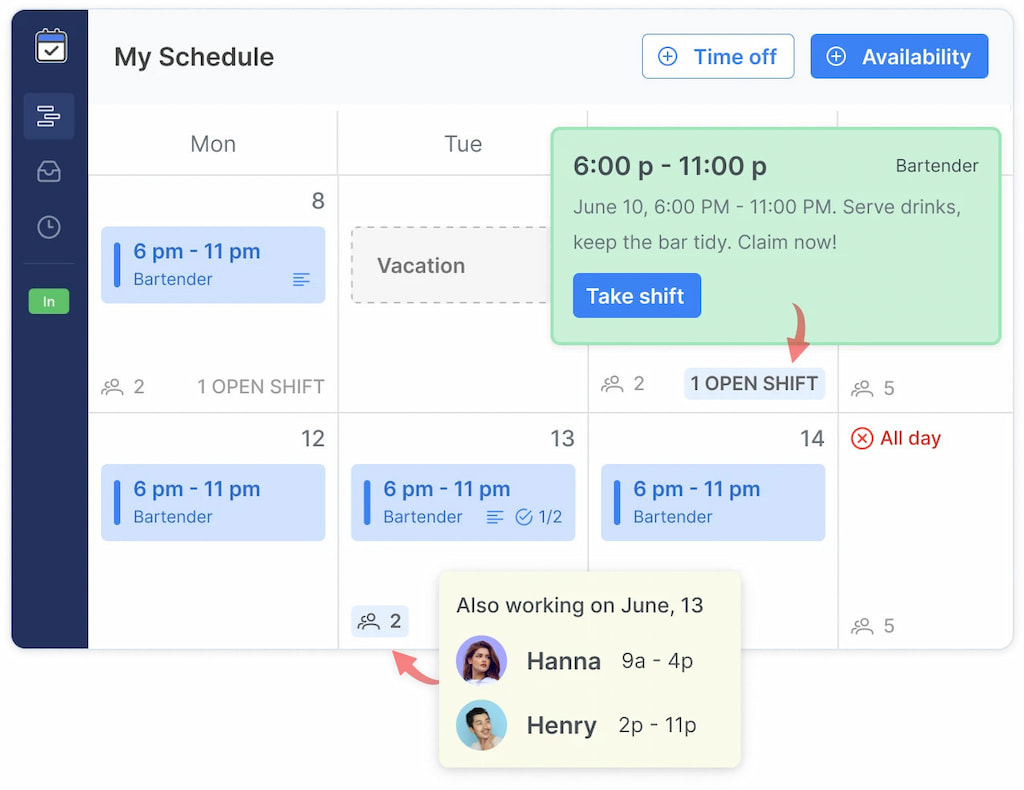
- ✅ Approvals & reality: route time-off and swap requests through a central inbox, and have staff clock in/out in the same system. Review scheduled-vs-actual hours each pay cycle to fix overtime or coverage gaps.
- 📊 Continuous improvement: track key KPIs—overtime hours, no-show rate, schedule build time, swap lead time, coverage gaps—and refine staffing and buffers.
For project-level time tracking, integrate Everhour directly. For operations anchored in shifts, Shifts by Everhour’s unified loop delivers faster, measurable ROI.
Best Practices and Actionable Tips
📅 Publish on a predictable schedule
- Choose a weekly release time (e.g., Thursdays at 4 p.m.). Predictability reduces swap chaos and churn.
- Use small overlap buffers where handovers matter—15–30 minutes is cheaper than coverage fallout, especially in healthcare, warehousing, and hospitality.
🕒 Open shifts before panic
- Post unfilled shifts 48–72 hours ahead so the right people can self-assign. Managers intervene only if necessary.
📝 Document swap policies like a product spec
- Define who can swap with whom, required lead times, blackout windows, and approval rules. Clarity prevents confusion and exceptions.
🔄 Rotate “undesirable” shifts deliberately
- Make fairness visible by rotating late nights and weekends. This boosts morale and lowers last-minute call-offs.
📊 Audit monthly, not yearly
- Review scheduled-vs-actual hours, no-shows, and overtime patterns every payroll cycle. Fix recurring issues instead of firefighting individual cases.
Comparison Table: Best Employee Rostering Software
| Tool | Key Features | Pricing/Plan | Ideal For |
| Shifts by Everhour | Drag-and-drop scheduling; open shifts & swaps; mobile apps; built-in time tracking; scheduled-vs-actual reports | Free & paid plans | Teams that want accurate rosters and time data in one place |
| Connecteam | Scheduling plus chat, tasks, and training; strong mobile UX; all-in-one deskless ops | Free & paid tiers | Deskless or field teams wanting all-in-one ops with rostering included |
| Homebase | Scheduling, time clock, and labor tools; simple setup for retail/hospitality | Free & paid plans | Retail or hospitality SMBs needing easy adoption and a generous baseline |
| Deputy | Compliance-aware scheduling, forecasting, and multi-location controls; robust reporting | Paid plans | Healthcare or enterprise operations with stronger compliance demands |
| 7shifts | Restaurant-first scheduling; POS-friendly ecosystem; shift feedback and labor tools | Free & paid plans | Hospitality groups with spiky demand and frequent shift changes |
| Sling | Simple roster builder with reminders and labor-cost cues; lean interface | Free & paid plans | Smaller teams aiming to “get off spreadsheets” this week |
| QuickBooks Time | Scheduling adjacent to payroll/accounting; attractive for QB ecosystems | Paid plans | Teams already running finance on QuickBooks that want tighter linkage |
| Apploye | Scheduling plus time tracking and workforce monitoring; clear dashboards and timesheets | Paid plans with trials | Time-tracking–centric workflows that want scheduling in the same place |
| Shiftboard | Enterprise-grade scheduling at scale; coverage planning and automation | Paid enterprise plans | Large, complex environments (manufacturing, logistics) that need advanced coverage planning |
Tool summaries and differentiators
Shifts by Everhour
The pragmatic choice when you want one place to plan shifts, approve changes, and verify reality—scheduled-vs-actual reporting and attendance without exports. Templates, open shifts, structured swaps, and mobile keep admin work low.

Connecteam
A roster engine inside a broader deskless-ops suite (chat, tasks, training). If you want fewer apps and a single mobile hub for field teams, the all-in-one model is compelling. Its own roster lists and comparisons underline that positioning.
![the 9 best when i work alternatives in 2023 [both paid and free]](https://blog-cdn.everhour.com/blog/wp-content/uploads/2023/01/connecteam.jpg)
Homebase
A widely recommended default for retail and restaurants thanks to approachable setup and a generous free baseline. Expect to upgrade for deeper analytics or multi-site complexity as you grow.
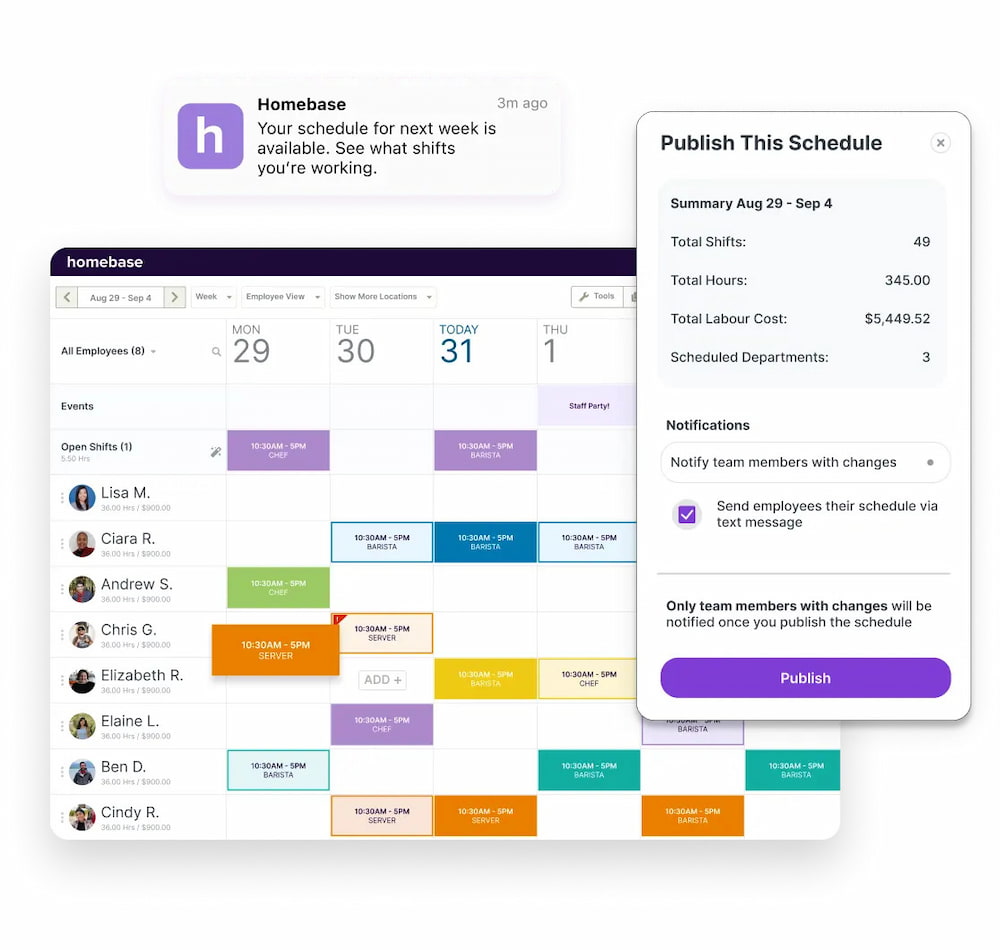
Deputy
Often chosen where compliance and forecasting are center stage. Controls, multi-location visibility, and reporting help larger teams maintain standards without manual policing.
![the 9 best when i work alternatives in 2023 [both paid and free]](https://blog-cdn.everhour.com/blog/wp-content/uploads/2023/01/deputy.jpg)
7shifts
Built for hospitality realities—spiky demand, POS alignment, and shift feedback keep weekly roster drama low and give managers actionable labor signals.
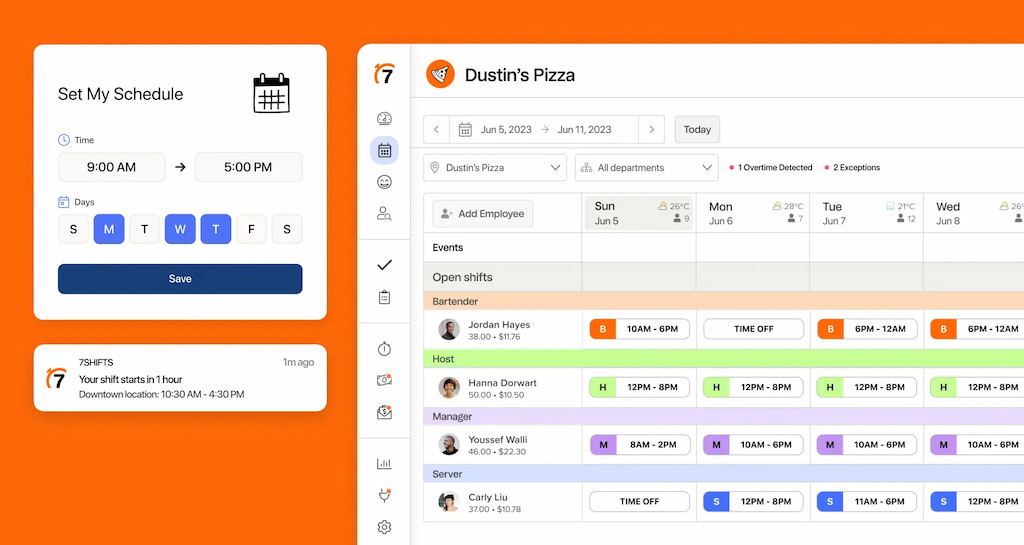
Sling
Minimalist and learn-it-fast. Ideal for smaller teams that need to stop juggling SMS threads and Excel by Friday, without big-suite overhead.
![the 9 best when i work alternatives in 2023 [both paid and free]](https://blog-cdn.everhour.com/blog/wp-content/uploads/2023/01/sling.jpg)
QuickBooks Time
Lean scheduling tied closely to the finance system of record. If your payroll/accounting runs on QuickBooks, proximity can simplify reconciliation.
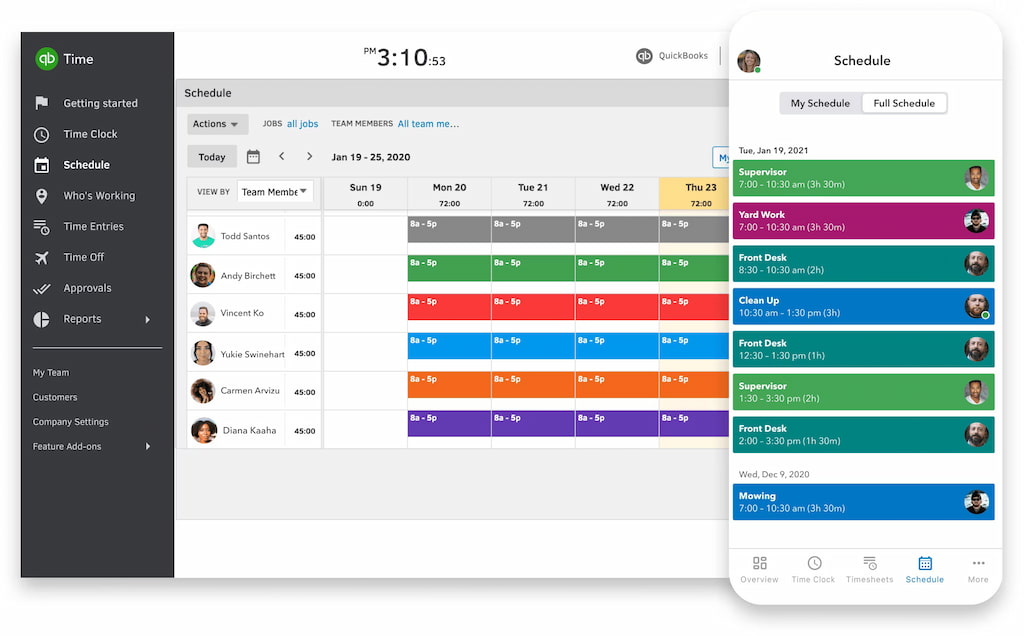
Apploye
A time-tracking–centric approach that includes scheduling and clear dashboards. For managers who live in timesheets and utilization, it keeps the focus where the work is. Apploye’s product pages emphasize combined scheduling + tracking for simpler control.
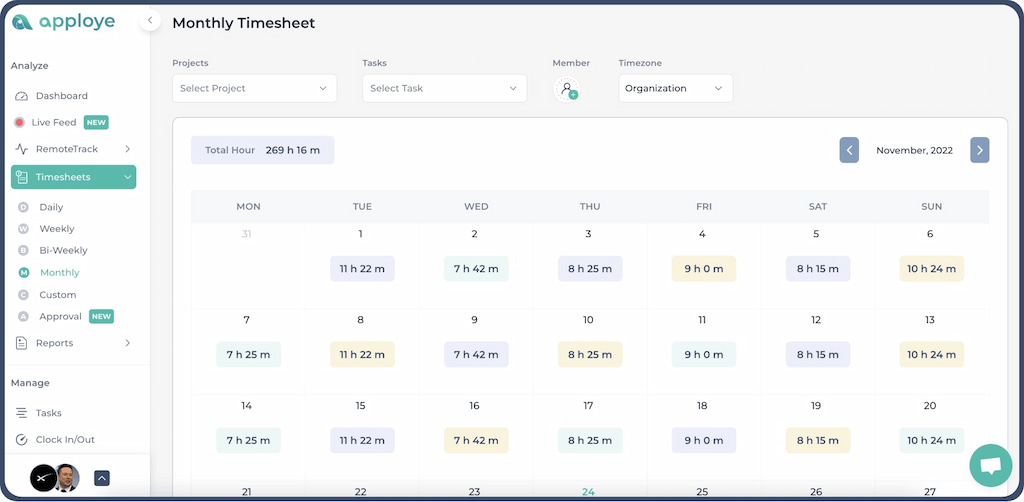
Shiftboard
Engineered for scale and complexity—manufacturing, logistics, and any environment where coverage planning is a science rather than a guess.
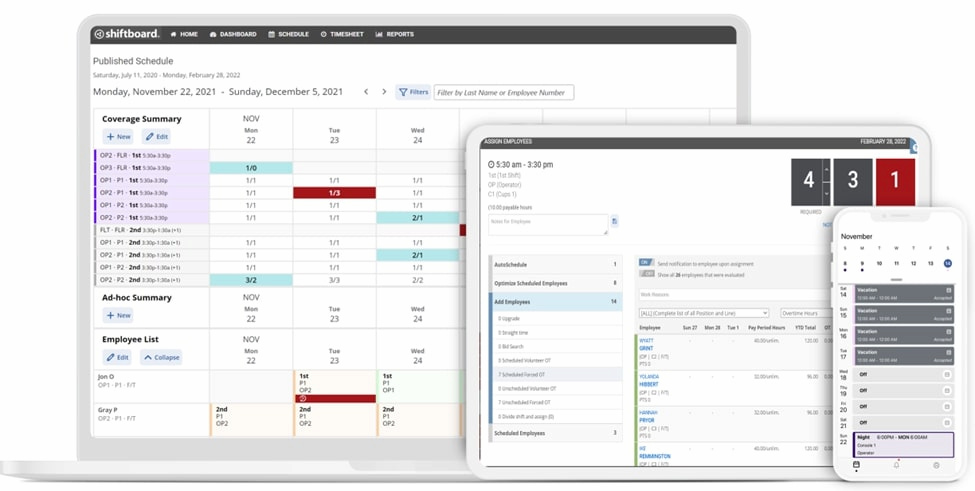
FAQ: Employee Rostering Software
What’s the difference between employee rostering software and a shared calendar?
A shared calendar doesn’t manage availability, swaps, rule checks, or attendance. Rostering software prevents conflicts at creation time and manages changes in-app, which is essential for accuracy, fairness, and compliance.
Which employee rostering software is “best overall”?
“Best” depends on constraints. If you want scheduling and time tracking in one place with scheduled-vs-actual reporting, start with Shifts by Everhour. If you want an all-in-one deskless-ops suite with chat/tasks/training plus rostering, Connecteam is a common pick in 2025 comparisons.
Do we really need time tracking with rostering?
If you pay hourly, yes. Without time data, you can’t reconcile schedule vs reality or quantify labor waste. Shifts by Everhour links both, speeding payroll and creating a clean audit trail.
How fast can we expect ROI after switching?
Teams that cut overtime leakage and scheduling admin typically see measurable ROI within two to three payroll cycles. Track a baseline first, then compare after rollout. [Insert verified stat from Gartner or Capterra here]
Can one tool handle multi-location rosters and permissions?
Yes. Modern platforms support location hierarchies, roles, and approval flows so local managers act quickly while HQ gets oversight. Confirm how each tool handles reporting and access as you scale.
Final Thoughts
The “best employee rostering software” isn’t a trophy—it’s the system your team will actually use every week. The moment you connect a clean roster with real time tracking and structured change workflows, operations shift from guesswork to data. If you want that connection without bolting multiple tools together, start with Shifts by Everhour: publish reliable schedules, empower self-service, clock time, and reconcile costs in one place. If managing shifts or tracking time sounds like your daily grind, Everhour keeps it all in one flow.
Sources consulted for landscape context: Connecteam’s online rostering software list and Apploye’s employee scheduling software overview.
